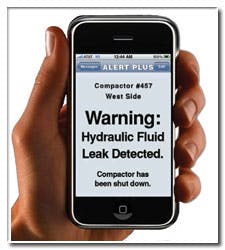What can you compare leakage to? I believe an appropriate analogy to preventing hydraulic leakage is losing weight. At one time or another, most of us have tried a variety of techniques to lose weight. Some were more successful than others. But unless you stuck with your commitment, the weight came back.
Granted, some people are lucky enough to not have to battle with their waistline or cholesterol count. Others just seem to have it in their nature to exercise regularly and eat right. I would compare this second group to a hydraulic or pneumatic system that has all of its connections brazed together: leakage usually isn't much of a problem.
On the other end of the weight-loss spectrum is people who know they should lose weight but do little about it. Their effort may amount to having a Diet Coke with their double cheeseburger. (Sound familiar?) Compare this to technicians who deal with leaks by using a drip pan or absorbent to collect the fluid. They treat the symptoms, not the cause.
Preventing leakage starts with an understanding of its root causes. Understanding, of course, comes from education, and this is where the continuing commitment comes into play. Talk to your suppliers about training materials to help you in your battle against leakage. Note, however, that you won't simply attend a couple of classes, put what you learn into practice, and be done. And remember to share the information with others, especially newcomers.
Studying leakage will teach you that one of the main culprits is the use of pipe fittings. So start your mission by doing what so many other companies have done: ban the use of pipe fittings. Pipe fittings are cheap and readily available, but that low price is the same temptation as a free piece of French Silk pie is to a dieter.
Another technique is simply to specify the right fitting for an application at the start. Leaks often are caused by a joint using three or more fittings screwed together, when one or two fittings of the right configuration would have done the same job. Every time you eliminate a fitting from a system, you eliminate a potential leakage point. Better still, a manifold containing multiple valves can eliminate dozens of fittings, along with sections of hose and tubing.
There's a lot more you can do. One is to become familiar with standard and proprietary fittings designed to be leak-free. Another is our website. Click here to see a list of articles dealing with leakage, with hyperlinks to each one. Or talk to your suppliers for their ideas on how to reduce leakage in your designs.
Finally, instead of that double cheeseburger, order a grilled chicken sandwich with your Diet Coke. I'll try to do the same.

Continue Reading
Continue Reading
BOOK 2, CHAPTER 12: Fluid Motor Circuits
March 18, 2009
Motor leakage variations
Oct. 18, 2006
Sponsored Recommendations
Sponsored Recommendations
All-In-One DC-UPS Power Solutions
March 13, 2024
Motor Disconnect Switches
March 13, 2024
Industrial Straight-Through Cable Gland
March 13, 2024

